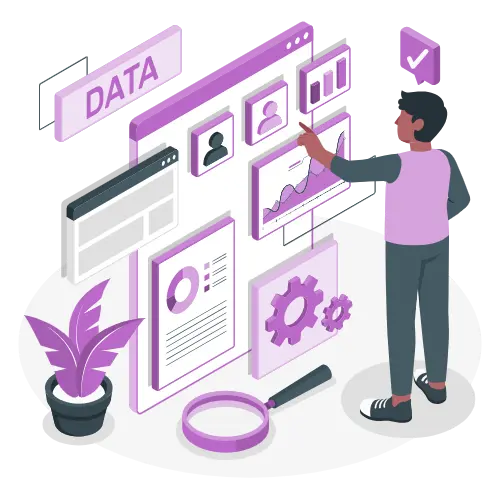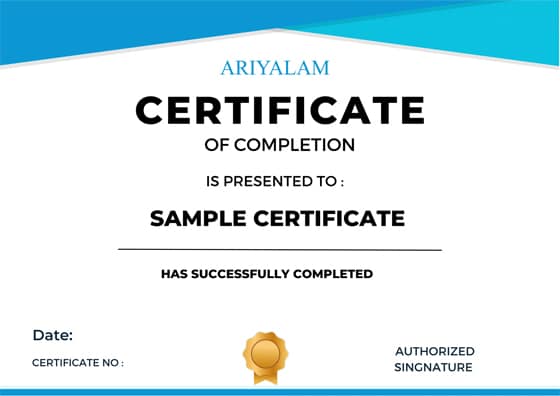Data Science Course Online
Our Data Science course online teaches students the fundamentals of data analysis and machine learning in Python. Whether you’re a beginner or an experienced professional, this class will teach you how to manipulate data, visualize it, use statistical techniques, and use important machine learning algorithms. Students obtain hands-on experience and effective skill development through practical projects, interactive exercises, and expert instruction. Hands-on experience allows them to efficiently enhance their talents. Experience and industry-relevant knowledge.

Data Science Course Fees
Key Features
Data Science Certification

Key Features
Data Science Certification

Online Data Science Course Prerequisites:
You don’t need to be an expert in technology to take an online data science course online. Nonetheless, a basic grasp of mathematics, especially statistics and probability, could be helpful. It also helps to know Excel and some basic programming, especially Python. A keen interest in problem-solving, data analysis, and experiential learning will enhance your entire experience and add enjoyment to the course.
Data Science Course Syllabus
Module 1: Introduction to Data Science
- Overview of Data Science, Machine Learning, Deep Learning, and Artificial Intelligence
- Types of Data Analytics: Descriptive, Diagnostic, Predictive, and Prescriptive
- Applications of Data Science in different industries.
Module 2: Introduction to Python
- Overview of Python and its applications in data science
- Installing Python, setting up IDEs (Jupyter Notebook, VS Code)
- Jupyter Notebook basics and useful shortcuts
Module 3: Python Basics
- Core data types: strings, integers, floats, and booleans
- Data structures: Lists, Dictionaries, Tuples
- Basic operations: slicing, IF statements, loops (for, while)
- Functions and arrays; selecting data by position and labels
Module 4: Essential Python Packages
Overview and usage of key packages:
- Pandas for data manipulation
- Numpy for numerical operations
- Matplotlib and Seaborn for data visualization
- Sci-kit Learn for machine learning basics
Module 5: Importing and Exporting Data
- Reading data from CSV, Excel, and SQL databases
- Saving and loading Python data objects
- Writing data to CSV, Excel, and JSON formats
Module 6: Data Manipulation Techniques
- Selecting rows and columns, renaming, and filtering data
- Sorting and grouping data
- Merging and joining datasets
- Aggregation and data munging for cleaning and preparation
Module 7: Statistics and Probability Essentials
- Measures of Central Tendency (Mean, Median, Mode) and Dispersion (Variance, Standard Deviation)
- Probability concepts and types (conditional probability, Bayes’ theorem)
- Skewness, Normal Distribution, and Bias-Variance Tradeoff
- Analyzing data deviation, outliers, and plotting techniques (box plot, scatter plot)
Module 8: Data Preprocessing and Feature Engineering
- Handling missing values (imputation techniques, e.g., KNN)
- Categorical encoding (one-hot encoding, label encoding)
- Data normalization and scaling
- Outlier analysis and treatment
- Correlation analysis and feature selection
Module 9: Introduction to Machine Learning Basics
- Supervised vs. Unsupervised Learning
- Error Metrics for Classification: Confusion Matrix, Precision, Recall, Specificity, F1 Score
- Error Metrics for Regression: MSE, RMSE, MAE, MAPE
Module 10: Supervised Learning Algorithms
- Linear Regression: slope, intercept, R-squared value
- Logistic Regression: odds ratio, probability of success/failure, ROC curve
- Bias-variance tradeoff and model evaluation
Module 11: Unsupervised Learning Algorithms
- K-Means Clustering and K-Means++ for grouping data
- Hierarchical Clustering: understanding dendrograms and distance measures
Module 12: Advanced Machine Learning Algorithms
- K-Nearest Neighbors for Classification
- Naive Bayes for probability-based classification
- Decision Trees (CART, C5.0) and Random Forests for predictive modeling
- Support Vector Machines (SVM) and Ensemble Techniques
FAQ
1. What is data science, and why is it important?
Data science is the study of data to identify trends and relevant information. It is significant because it allows businesses and individuals to make better decisions based on data rather than guesswork.
2. Do I need a coding background to learn data science?
No, you do not require a coding background. Many data science courses begin with the fundamentals, and you will master vital programming abilities in Python throughout the course.
3. What skills will I learn in a data science course online?
You will study Python programming, data analysis, statistics, data visualization, and machine learning. These abilities enable you to examine data, uncover insights, and create prediction models.
4. What kinds of jobs can I get with data science skills?
With data science abilities, you can work as a data analyst, data scientist, business analyst, or machine learning engineer. Many sectors employ data science practitioners.
5. Is mathematics important for Data Science?
Yes, math—particularly statistics, probability, and linear algebra—is essential in Data Science for designing algorithms, conducting analysis, and comprehending data patterns. These fundamental concepts are frequently included in courses to aid comprehension.
6. What top companies have Jobs in Data Science?
Accenture, Google, Microsoft, IBM, Deloitte, Wipro, and More.
Enquiry Now
